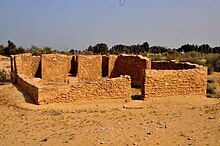Εκκλησία του Τζουμπάιλ
Η Εκκλησία του Τζουμπάιλ (κλασικά συριακά: ܥܕܬܐ ܕܡܕܢܚܐ ܕܐܬܘܖ̈ܝܐ) είναι χριστιανικός ναός του 4ου αιώνα κοντά στο Τζουμπάιλ, μια πόλη στην ανατολική επαρχία της Σαουδικής Αραβίας στις ακτές του Περσικού Κόλπου. Είναι μια από τις παλαιότερες εκκλησίες στον κόσμο. Περιέχει δύο ακόμη ορατούς σταυρούς που έχουν λαξευθεί στον τοίχο εκατέρωθεν της μεσαίας εσωτερικής θύρας που οδηγεί από τον κεντρικό κλίτο προς το ιερό.[1]

Η εκκλησία ανασκάφηκε από το Τμήμα Αρχαιοτήτων της Σαουδικής Αραβίας το 1987. Από το 2008, τα αποτελέσματα της ανασκαφής δεν είχαν δημοσιευτεί.[2]
Χρονολογία Επεξεργασία
Η χρονολογία της εκκλησίας του Τζουμπάιλ είναι αμφιλεγόμενη. Ορισμένες πηγές την καταγράφουν στον τέταρτο αιώνα,[1] ενώ άλλες την τοποθετούν στον έβδομο. Περιέχει κονίαμα, το οποίο υποδηλώνει ότι είναι της ίδιας ιστορικής περιόδου με παρόμοιες γνωστές χριστιανικές τοποθεσίες όπως το αλ-Κουσούρ, το Σιρ Μπάνι Γιας και το Χαργκ.[2]
Ιστορία Επεξεργασία
Ανακαλύφθηκε το 1986, αρχικά ανήκε στην Εκκλησία της Ανατολής, έναν κλάδο του Ανατολικού Χριστιανισμού στη Μέση Ανατολή. Η πλειοψηφία των υποστηρικτών της είναι Ασσύριοι.
Πρόσφατα, τοποθετήθηκε φράχτης γύρω από την εκκλησία για να μην την δουν πιθανοί τουρίστες. Ωστόσο, οι φράχτες δεν εμπόδισαν τους ντόπιους να εισέλθουν για να βανδαλίσουν και να καταστρέψουν το κτίριο.[3][4][5][6][7]
Δείτε επίσης Επεξεργασία
Παραπομπές Επεξεργασία
- ↑ 1,0 1,1 «Saudi Arabia has the Oldest Standing Church on Earth?». YouTube.
- ↑ 2,0 2,1 Carter, R.A. (2008). «Christianity in the Gulf during the first centuries of Islam» (στα αγγλικά). Arabian Archaeology and Epigraphy 19 (1): 71–108. doi:. ISSN 0905-7196. https://onlinelibrary.wiley.com/doi/10.1111/j.1600-0471.2008.00293.x.
- ↑ J.A. Langfeldt, "Recently Discovered Early Christian Monuments in Northeastern Arabia", Arabian Archaeology and Epigraphy, 5 (1994), 32–60 [1].
- ↑ Changing Identities in the Arabian Gulf: Archaeology, Religion, and Ethnicity in Context T. Insoll – The Archaeology of Plural and Changing Identities, 2005 – Springer "He mentions how access to the monuments was restricted, and how the church in Jubail supposedly had its impressed crosses obliterated. Besides vandalism, the presence of these Christian remains caused a debate over what exactly they signified."
- ↑ The Nestorians in the Gulf: Just Passing Through? Recent Discoveries on the Island of Sir Bani Yas, Abu Dhabi Emirate, UAE J Elders – Archaeology of the United Arab Emirates, 2003 "There are sites along the Gulf coast of Saudi Arabia, at Jubail (Langfeldt 1994), and inland at Thaj and also Jebel Berri (Potts 1994). There is at least one. possibly two. church sites on Qatar."
- ↑ A Pre-Islamic Christian site on Sir Bani Yas G R D King, P Heliyer – Tribulus, 1994 ".. Bani Yas discovery can also be related to the discovery of a church with a fine cross at Failaka, in Kuwait, in 1990 by Vincent Bernard and JF Salles. Their stucco crosses are dated to the Fifth-Sixth Centuries AD. The discovery of two churches and crosses at Al Jubail and Thaj ..."
- ↑ Crossing the Line L Castoro – 2002 – The lost churches of the Arabian Gulf: recent discoveries on the islands of Sir Bani Yas and Marawah, Abu Dhabi emirate, United Arab Emirates J Elders – Proceedings of the Seminar for Arabian Studies, 2001 "There are two known sites along the Gulf coast of Saudi Arabia, at Jubail (Langfeldt 1994) and slightly inland at Jebel Berri (Potts 1994). There are unconfirmed but persistent reports of at least one, more probably two church sites on Qatar."